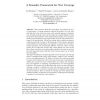Free Online Productivity Tools
i2Speak
i2Symbol
i2OCR
iTex2Img
iWeb2Print
iWeb2Shot
i2Type
iPdf2Split
iPdf2Merge
i2Bopomofo
i2Arabic
i2Style
i2Image
i2PDF
iLatex2Rtf
Sci2ools
ATVA
2006
Springer
2006
Springer
A Semantic Framework for Test Coverage
Abstract. Since testing is inherently incomplete, test selection is of vital importance. Coverage measures evaluate the quality of a test suite and help the tester select test cases with maximal impact at minimum cost. Existing coverage criteria for test suites are usually defined in terms of syntactic characteristics of the implementation under test or its specification. Typical black-box coverage metrics are state and transition coverage of the specification. White-box testing often considers statement, condition and path coverage. A disadvantage of this syntactic approach is that different coverage figures are assigned to systems that are behaviorally equivalent, but syntactically different. Moreover, those coverage metrics do not take into account that certain failures are more severe than others, and that more testing effort should be devoted to uncover the most important bugs, while less critical system parts can be tested less thoroughly. This paper introduces a semantic approac...
| Added | 20 Aug 2010 |
| Updated | 20 Aug 2010 |
| Type | Conference |
| Year | 2006 |
| Where | ATVA |
| Authors | Laura Brandán Briones, Ed Brinksma, Mariëlle Stoelinga |
Comments (0)

